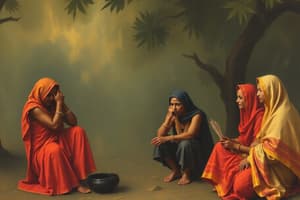Podcast
Questions and Answers
What caused social changes in the subcontinent?
What caused social changes in the subcontinent?
- Economic developments
- Political changes
- Caste systems
- All of the above (correct)
What unites members of a tribe?
What unites members of a tribe?
Kinship bonds
Which activities did tribes commonly engage in to obtain their livelihood?
Which activities did tribes commonly engage in to obtain their livelihood?
- Hunting and gathering
- Agriculture
- Herding
- All of the above (correct)
Tribal societies followed the social rules prescribed by the Brahmanas.
Tribal societies followed the social rules prescribed by the Brahmanas.
What is one way historians today gather information about tribal histories?
What is one way historians today gather information about tribal histories?
The __________ in Punjab was a powerful tribe that controlled large territories.
The __________ in Punjab was a powerful tribe that controlled large territories.
Who was Kamal Khan Gakkhar?
Who was Kamal Khan Gakkhar?
Which tribes dominated the north-eastern part of the subcontinent?
Which tribes dominated the north-eastern part of the subcontinent?
What happened to the Chero chiefdoms under Raja Man Singh?
What happened to the Chero chiefdoms under Raja Man Singh?
The Mundas and Santals were insignificant tribes in terms of population.
The Mundas and Santals were insignificant tribes in terms of population.
Flashcards are hidden until you start studying
Study Notes
Tribal Societies in the Subcontinent
- Many societies in the subcontinent did not follow the social rules prescribed by the Brahmanas.
- These societies were not divided into numerous unequal classes and were often called tribes.
- Members of each tribe were united by kinship bonds.
- Many tribes obtained their livelihood from agriculture, hunting and gathering, or herding.
- Some tribes were nomadic and moved from one place to another.
- Tribal groups controlled land and pastures jointly and divided these among households according to their own rules.
- Large tribes lived in forests, hills, and clashed with more powerful caste-based societies.
- Tribes retained their freedom and preserved their separate culture.
- The caste-based and tribal societies depended on each other for their diverse needs.
Identifying Tribal Peoples
- Contemporary historians and travellers give scanty information about tribes.
- Tribal people did not keep written records, but preserved rich customs and oral traditions.
- Present-day historians have started using oral traditions to write tribal histories.
Location and Dominance of Tribal Groups
- Tribal people were found in almost every region of the subcontinent at different points in time.
- Some powerful tribes controlled large territories.
- In Punjab, the Khokhar tribe was influential in the 14th and 15th centuries. The Gakkhars became more important later on, with their chief Kamal Khan Gakkhar being made a noble (Mansabdar) by Emperor Akbar.
- In Multan and Sind, the Langahs and Arghuns dominated extensive regions before being subdued by the Mughals.
- The Balochis were another large and powerful tribe in the north-west.
- In the western Himalaya lived the shepherd tribe of Gaddis.
- The distant north-eastern part of the subcontinent was dominated by tribes like the Nagas, Ahoms, and many others.
- In many areas of present-day Bihar and Jharkhand, Chero chiefdoms had emerged by the 12th century.
- Raja Man Singh, Akbar's famous general, attacked and defeated the Cheros in 1591.
- Under Aurangzeb, Mughal forces captured many Chero fortresses and subjugated the tribe.
- The Mundas and Santals were among the other important tribes that lived in this region and also in Orissa and Bengal.
Studying That Suits You
Use AI to generate personalized quizzes and flashcards to suit your learning preferences.




